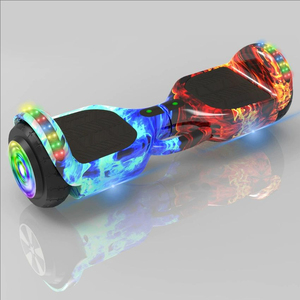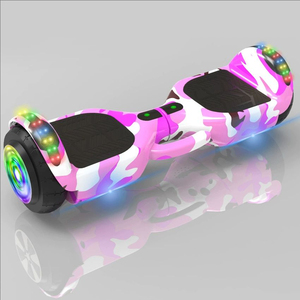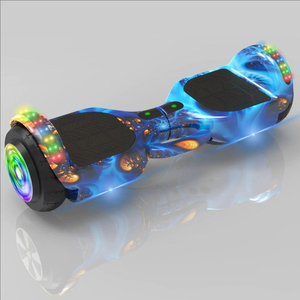
All categories
Featured selections
Trade Assurance
Buyer Central
Help Center
Get the app
Become a supplier

(1467 products available)














































The hoverboard self balancing comes in different types that cater to distinct preferences and requirements. Each type offers a unique riding experience, emphasizing various elements such as speed, durability, and intended use. Here’s an overview of the major kinds:
Self-balancing hoverboards are popular personal transportation devices that can be used in different areas and applications. Below are some common scenarios where they are used:
Urban Commuting
Self-balancing hoverboards can be used for short-distance commuting in cities. They can be a great alternative to public transport and can be used to avoid traffic jams. Besides, they can be used to complement other means of transport, especially when covering short distances to and from public transport stations.
Recreation and Fun
Hoverboards are popular for recreational activities. People can use them for fun and enjoyment while cruising around parks, streets, and other open areas. Also, they can be used for hobbies by enthusiasts who enjoy the thrill of riding.
Indoor Use
Self-balancing boards can be used indoors in large spaces such as warehouses and large offices. This can help move from one point to another quickly. Moreover, they can be used for training and practice purposes, especially for new riders who want to learn balancing techniques in controlled environments.
Delivery Services
Businesses can use self-balancing boards in the delivery industry to facilitate quick deliveries, especially when delivering food, packages, and other small items in urban areas. This is because they can maneuver through traffic and narrow streets more easily than cars.
Events and Expos
Self-balancing scooters can be used in trade shows, exhibitions, and events to enhance movement around event venues. Additionally, they can be used for guided tours in museums, amusement parks, and large corporate facilities.
Special Needs
Self-balancing boards can be used by individuals with mobility issues. This tool can provide an alternative means of movement, especially for people who find it difficult to walk long distances.
School and Campus Use
Hoverboards can be used in large school campuses and universities by students to move between classes quickly. Also, they can be used by staff members to navigate large campuses and cover large distances in a short time.
Warehouse and Large Facilities
Self-balancing boards can be used by employees to facilitate movement in large warehouses and facilities. This can help when checking inventory and overseeing different areas quickly.
Security Patrols
Hoverboards can be used by security personnel to patrol large areas such as malls, parks, and corporate properties. This can help them respond quickly to incidents and monitor the premises effectively.
When purchasing bulk self-balancing scooters, business owners should consider various factors to ensure they get products that meet their clients' needs. Below are some of the primary factors.
Purpose and Usage
Buyers should consider the primary purpose customers will use the hoverboards for. For instance, if the customers intend to use the self balancing scooters for commuting, they should get models with larger batteries and higher weight capacities. Similarly, if customers intend to use the boards for recreational purposes, they should look for models specifically designed for off-road use.
Age and Skill Level
Business owners should get hoverboards suitable for different age groups. For instance, models with safety features, such as speed limiters and lower speed settings, are ideal for children and beginners. At the same time, those boards suitable for adults should have higher speed and performance capabilities.
Battery Life and Range
Business owners should pay attention to the battery specifications and overall lifespan of the self balancing scooter. Ideally, they should get models with efficient batteries that can offer long ride times and cover considerable distances. They should also ensure the batteries have short charging times.
Weight Capacity
Buyers should ensure the hoverboards support a wide range of weights. More importantly, they should ensure the models' maximum weight capacity can accommodate their target customer's body weight.
Speed and Performance
Business owners should look for models that can achieve suitable speeds and performance levels. Ideally, they should settle for boards with powerful motors to enable faster rides and better hill climbing capabilities.
Safety Features
Safety is a key consideration when choosing a hoverboard. Therefore, business owners should look for models with self-balancing features to enhance stability and prevent falls. They should also ensure it has LED lights for illumination, particularly when riding in low-light conditions. In addition, they should ensure the model has quality fire and overheat protection.
Durability and Build Quality
To ensure the customers get products that will last, business owners should closely evaluate the build quality of the hoverboards. They should look for models constructed with durable materials that can withstand regular use and various environmental conditions.
App Connectivity and Features
Buyers should get hoverboards with app connectivity. Such models offer additional functionalities, such as customizable settings and tracking performance metrics. They should also ensure the boards have useful features, such as GPS tracking.
Certifications and Standards
To ensure they stock safe and quality products, business owners should look for hoverboards with appropriate certifications. They should also ensure the models meet relevant safety standards.
Wholesale and Bulk Options
If buying from a manufacturer, business owners should inquire about wholesale options. They should also request samples to test the products' quality before placing a large order.
Self-balancing hoverboards come with different features that improve performance, safety, and overall user experience. Here are the key features and design elements of self-balancing hoverboards:
Battery and Charging System
Most self-balancing hoverboards use lithium-ion batteries due to their high performance and safety. Some boards also have charging indicators to show the current battery status. Additionally, they come with fast charging capabilities, enabling users to recharge their devices quickly. They also have overcharge protection to prevent damage to the battery caused by overcharging.
Weight Capacity
Self-balancing hoverboards have different weight capacities that range from 45-220 kgs. The weight capacity depends on the materials used in the construction and the intended use. Those with high weight capacity are suitable for heavy users and rough usage, while those with low capacities are ideal for light users and regular usage.
Design and Build Quality
Self-balancing scooters come in different sizes and dimensions. The size and dimensions affect maneuverability and stability. Smaller boards are easy to maneuver and carry around, while larger ones offer more stability and comfort. They have durable construction that consists of quality materials such as ABS plastic and aluminum. This ensures longevity and the ability to withstand regular use and rough handling. Additionally, they come with anti-slip foot pedals that ensure stability and safety during ride.
Motor Power and Speed
Self-balancing scooters have different motor powers that range from 100 to 700 watts. High motor power results in high speeds and improved performance on steep hills and rough terrains. Low motor power is suitable for flat terrains and regular usage. The boards have a top speed of around 10 to 20 km/h. The speed level depends on the motor power and the terrain type. They also have dual motors, which provide better performance, especially on rough terrains.
Safety Features
To enhance user safety, self-balancing scooters are equipped with several safety features. They include LED lights for visibility in low-light conditions, reflective strips for increased visibility, and brake systems that include mechanical brakes and electronic brakes. Some boards also come with fire-resistant casing to protect the board from fires caused by battery failure.
Connectivity and Smart Features
Some self-balancing scooters come with smart features. These include Bluetooth connectivity, where users can connect the board to their smartphones. The connection enables them to access various features, including performance tracking and firmware updates. Some boards also come with built-in speakers.
Q1. How to know if a hoverboard is safe?
A1. To know if a hoverboard is safe, check if it has UL 2272 certification. This certifies that the device has undergone testing for electrical and fire safety. Also, look for brands that have good reviews and aren't subject to frequent recalls.
Q2. What is the lifespan of a self-balancing hoverboard?
A2. The lifespan of a self-balancing hoverboard varies depending on its quality and how it's maintained. Generally, it can last between 3 to 5 years. After this period, the battery life diminishes, and the performance declines significantly.
Q3. Can a hoverboard be used as a mode of transportation?
A3. Yes, a hoverboard can be used as a mode of transportation. In fact, there are even professionals who use them for commuting or running errands. However, it mostly depends on the hoverboard's specifications, like battery life and range. Also, it can be used for such purposes if it supports the rider's weight.
Q4. Are hoverboards self balancing good for kids?
A4. Whether a hoverboard is good for kids or not depends on its specifications. Some models are designed specifically for children. They have lower speed levels and smaller body frames. Such models are ideal for kids. However, older children can use the standard models, which are faster and can support higher weights.